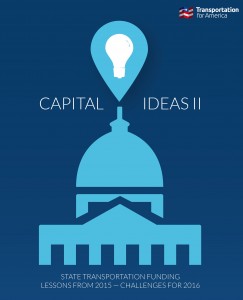Part One: State Transportation Legislation Year in Review
An overview of the trends and lessons of 2015
Legislatures convened in all 50 states this year and closing the gaps in transportation funding was at the top of the priority list for many. In 2015 state legislators in 26 states introduced legislation and 12 states succeeded in passing bills to raise new funding.
Fuel taxes still the dominant form of funding
As in previous years, changes to fuel taxes were one of the most common changes to revenue sources: 9 of 12 states raising new revenue did so through adjustments to fuel tax rates. Rather than straight-ahead rate increases, several states enacted — and many more debated — new rates that would track future fuel price increases, construction cost inflation, or increasing vehicle efficiency. Georgia, Kentucky, North Carolina and Utah each enacted new variable rate taxes or adjusted variable rates this year.
Legislators this year were bolstered by T4America’s own research that found in the 10 states that raised transportation revenue from 2012 to 2014, 98 percent of representatives who supported those proposals — regardless of party — won their next primary.
A new focus on selecting projects that deliver preferred outcomes
Limited funding and uncertain federal support are also forcing states to critically evaluate how they select, design and build projects. Along with raising new funds, many states have passed policies to ensure their transportation investments are achieving the public’s desired outcomes and getting the most benefit from every dollar spent.
When gas tax revenues were increasing every year, as they did for decades, there was little impetus to improve the processes to ensure that money gets spent wisely or on the most cost-effective projects. But that’s no longer the case. (Even in these states moving to raise money now, due in large part to federal funding levels that haven’t grown in any meaningful way in years now, many are just filling the gaps of lost revenue and purchasing power.)
These funding challenges have helped catalyze a greater focus on getting the most bang for the buck by improving how we select projects and aiming the billions invested annually at projects with more measurable, quantifiable benefits that matter to transportation users. While this is one of the areas in which T4America would like to see more progress made — few meaningful reforms passed in 2015. Improving transparency and accountability to restore the trust of citizens in a process that they think is murky, mysterious and wholly political is a smart way to get them on board with raising taxes or fees in any way to invest.
Voters want to know the money will be spent well before they commit to giving their decision makers any more of it.
Louisiana’s HB342 — led by START Network member, Speaker Pro Temp Walt Leger (D-New Orleans) — creates a new, more transparent, merit-based process for the state to select transportation projects. Similarly, Texas’ HB20 directs the state’s transportation commission to develop new criteria and metrics for evaluating projects. In Wisconsin, the legislature, through the authority of the Joint Legislative Audit Committee, initiated an audit of the transportation projects in the state’s planning pipeline to ensure that those projects on the list meet the current and realistic needs of the state.(Virginia’s policy-oriented bill is profiled at length in the second half of this report.)
More local funding power and responsibility
Faced with increasingly constrained transportation budgets, state legislators are looking for new sources of funding to limit the tax increases which they must impose. To allow for more funding to flow to transportation projects — particularly projects like local streets, transit, sidewalks and bike routes — legislatures are granting local governments new authority to raise money to finance them.
Legislation in Utah, South Dakota, Washington and Georgia leaves certain projects for local governments to cover and gives these governments new options for raising local revenue.
Utah’s HB362 (profiled at length in the second half of this report) uses a new percentage gas tax increase to fund state highway projects, while allowing counties, with voter approval, to raise local sales tax revenue for transit, local streets, bike and pedestrian projects, or other local needs. South Dakota’s SB1 lets counties and townships raise local property taxes to fund road and bridge repair. Georgia’s HB170 includes new ways for counties or multi-county regions to raise new local option sales taxes to fund packages of local projects. Washington’s SB5987 package allows the Seattle region’s Sound Transit to put new regional sales taxes, property taxes, or vehicle fees before voters, allowing the agency to raise $15 billion to fund the next phase of the region’s transit plan. This issue is expected to be on the ballot in 2016.






